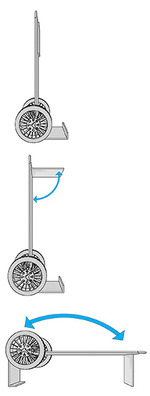The Kabwet Clinic
 Sunday, February 17, 2013 at 2:11PM
Sunday, February 17, 2013 at 2:11PM The Kabwet Clinic helps to both bring medical aid to Haitians in need that may not otherwise be able to travel to or afford a visit to a hospital. It combines modular, secure storage units with a durable, versatile cart to bring supplies and opportunities to the more remote, rural settings of Haiti. The cart was designed to travel over most terrains, to be easily repaired with the replacement of readily available parts (i.e. used car tires, scrap wood/metal), and to transform from a vehicle to a work surface.
 Transformation of Cart into Table
Transformation of Cart into Table
The cart would be stocked and distributed from hospitals around the country. They can be loaded onto a truck, towed by motor vehicle, donkey, or pushed by person. This style of pushed cart is often used in Haiti, but with more found materials and handmade construction. This cart could be manufactured in the US, but the use of simple construction techniques would allow for more carts to be built in Haiti with whatever material is available.
 Cart functioning as a work surface
Cart functioning as a work surface
The storage containers were designed for multi-functionality in that they are water-tight containers, can be used for seating or work surfaces, and include a detachable connection that allows for the use of other found containers with the entire unit. A critique given about the containers was that they would initially have to be fabricated in the US, an unlikely and difficult solution to the problem at hand. With the design of a specific connection detail, however, virtually any container could be used in this mobile clinic system.
One of the features of the Kabwet Clinic is the break-away medical kit. In a response to an emergency, it would be used, once the cart had arrived to a village and set up camp, to venture into the more remote locations to address any problems found. The break-away kit would also be used to travel to rural homes and help educate citizens on proper first aid. One of the most frequent causes of serious injury or infection is the mistreatment or neglect to care for minor injuries when they first happen. The break-away kit includes graphic directions to address the language barrier, and to help educated Haitians on proper first aid techniques.
 Mitzi Coker
Mitzi Coker
I really like the design of the Kabwet Clinic. The efficient use of space and the carts ability to be transformed into an examination table is a great idea. The over-all design is pleasing, compact, and well thought out. I think your thoughts on having the containers (baskets) woven by locals is a really good idea. Everything that can be manufactured locally is great for the economy and also less expensive due to shipping costs and transportation issues. Just curious...How did you come up with the name of the clinic? Did it have to do with the tires you used on the cart?
Mitzi Coker
 All-Terrain,
All-Terrain,  Haiti,
Haiti,  Mobile Clinic,
Mobile Clinic,  Mobile Medical Unit in
Mobile Medical Unit in  Wilson Sawyer
Wilson Sawyer 





Reader Comments